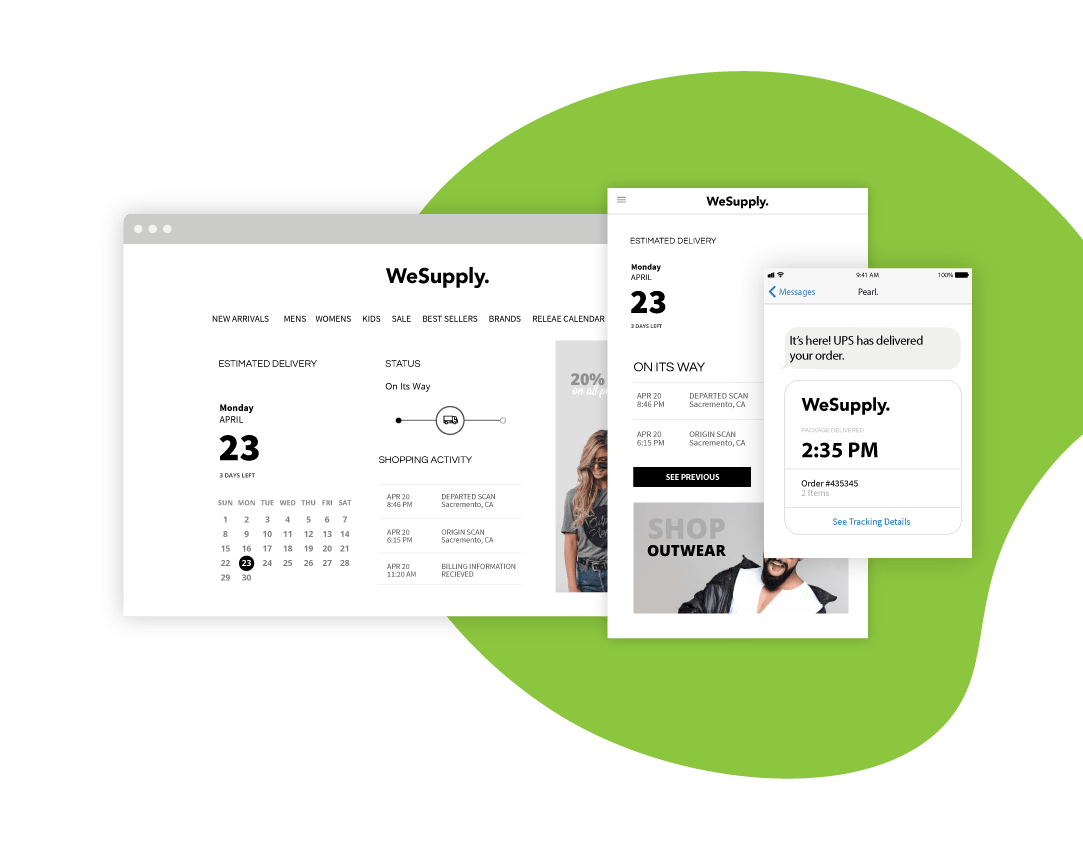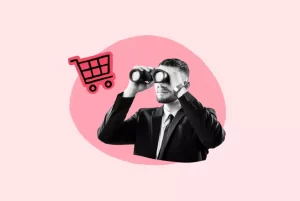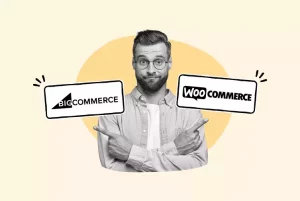
Latercase: Reducing WISMO with Delivery Emails & The Power of Conversational AI
Learn how Latercase has drastically reduced “Where is my order?” tickets using delivery emails and the power of conversational AI.
Shipping, Tracking & Notifications
Boost customer experience and reduce support tickets
Realtime order and shipment tracking
Proactive order and shipping notifications
AI-Enhanced Discounted Labels
Predictive pre-purchase estimated delivery dates
Self-Serivce branded order tracking
Effortless experience delivered
Identify and Resolve Order Issues
Realtime order and shipment tracking
Make returns profitable and delight customers
Flexibility to define any return destinations & conditions
Simplify returns for your customers and team
Incentivize exchanges over returns
Returns management made easy for your team
Returns management made easy for your team
Easy claims and smart upsells
Understand why your customers are returning
In-Store & Curbside Pickup
Unify the online and the in-store experience
Hassle-free pickup experience for customers
In-Store dashboard to keep operations streamlined
In-Store and Online orders unified
Drive foot-traffic to your stores
Shipping, Tracking & Notifications
Boost customer experience and reduce support tickets
Realtime order and shipment tracking
Proactive order and shipping notifications
AI-Enhanced Discounted Labels
Predictive pre-purchase estimated delivery dates
Self-Serivce branded order tracking
Effortless experience delivered
Identify and Resolve Order Issues
Realtime order and shipment tracking
Make returns profitable and delight customers
Flexibility to define any return destinations & conditions
Simplify returns for your customers and team
Incentivize exchanges over returns
Returns management made easy for your team
Returns management made easy for your team
Understand why your customers are returning
In-Store & Curbside Pickup
Unify the online and the in-store experience
Hassle-free pickup experience for customers
In-Store Dashboard to keep operations streamlined
In-Store and Online orders unified
Drive foot-traffic to your stores
Boost customer experience and reduce support tickets
Realtime order and shipment tracking
Proactive order and shipping notifications
AI-Enhanced Discounted Labels
Predictive pre-purchase estimated delivery dates
Self-Serivce branded order tracking
Effortless experience delivered
Make returns profitable and delight customers
Flexibility to define any return destinations & conditions
Simplify returns for your customers and team
Incentivize exchanges over returns
Returns management made easy for your team
Equip your team for precise return checks.
Understand why your customers are returning
Unify the online and the in-store experience
Hassle-free pickup experience for customers
In-Store Dashboard to keep operations streamlined
In-Store and Online orders unified
Drive foot-traffic to your stores
Find the answer to all your questions
Take a step by step trip through our functionality to see how we can improve your ecommerce processes.
Explore the most comon questions about WeSupply
Calculate the ROI that WeSupply can bring you
Request a no strings attached review of your current shopping experience and missed conversion opportunities
Read actionable articles on how to optimize your post-purchase experience and decrease support tickets
Get inspired by stories of how our customers implemented an effortless post-purchase experience
Wondering if WeSupply is a good fit for you? Read through our use cases to see how we can help you increase conversion & improve CX!
A Deep Dive into Top Companies' Order Tracking & Returns Strategy
Find the answer to all your questions
Explore the most comon questions about WeSupply
Calculate the ROI that WeSupply can bring you
Request a no strings attached review of your current shopping experience and missed conversion opportunities
Take a step by step trip through our functionality to see how we can improve your ecommerce processes.
Read actionable articles on how to optimize your post-purchase experience and decrease support tickets
Get inspired by stories of how our customers implemented an effortless post-purchase experience
A Deep Dive into Top Companies' Order Tracking & Returns Strategy
Wondering if WeSupply is a good fit for you? Read through our use cases to see how we can help you increase conversion & improve CX!
Four easy-to-implement optimizations that will reduce the workload for your customer service department this holiday season!

If anyone deserves the MVP award after a long, busy holiday shopping season, it’s the customer service department. Your agents are responsible for customer satisfaction, and ultimately loyalty and retention. This gets tougher during the peak retail season with a large influx of orders from new customers and gift givers. These shoppers are more likely to have questions, anxieties, and post purchase dissonance, which adds up to an increased workload.
The National Retail Federation predicts that 2021 holiday sales will increase 3.8% in November and 4.2% in December, year-over-year. The good news is that this means $727.9 billion and $730.7 billion in spending. The bad news is that it inevitably means a whole lot of holiday support tickets for your team.While there’s no silver bullet for online retailers to eliminate all support requests, there are certainly ways to reduce them.
This article highlights four essential changes you should make to reduce tickets and optimize customer service efficiency for holiday 2021.
The product page is the ultimate pre-purchase battleground, where presentation is everything. Optimizing this page will increase conversion, mitigate dissonance, and lessen future support calls. We’ve put together a quick checklist to see if your product page is ready for the holiday season.
Product Descriptions: Do long product descriptions work better than short ones? The answer is actually that they both work, and it’s best to include both! 79% of shoppers scan descriptions, so offering a short bulleted list that gets to the point is highly effective. Having an expandable version that is richer and more in-depth will convert those customers who like to read.
Images: 22% of customer returns are due to an item looking different in person. By focusing on crisp, beautiful imagery that captures the essence of your products you will mitigate these future issues.
Size Chart: Bizrate Insights recently conducted a survey that found 55% of shoppers cited sizing issues as their number one reason for returning a product. Getting ahead of this issue could cut down on half of your customer service calls if your business is apparel!
Customer Reviews: In today’s social-driven world, peer reviews are crucial in the consideration stage. Sellbrite has found that displaying reviews can increase conversion by 270% and that 72% of consumers won’t take action without them!
Estimated Delivery Date: Avoid “Where’s my order” calls by setting expectations from the start using an estimated delivery date. This combines processing time, customer location, and carrier data to give an exact arrival date.
Q&A: By letting users ask questions and get the appropriate answers during the pre-purchase you can cover ground that goes way beyond your product description. This section also demonstrates that other people are also interested in the product, and use the consumer-generated content approach to aid conversion.
FAQ: Harvard Business Review found that brands had an 86% higher chance to convert customers when they made it easy for them to gather relevant product information. They also added that there was a 9% chance for repurchase, and a 115% chance to be recommended to a friend! By validating customers early in the pre-purchase journey you mitigate the chance of regret later.
Returns Policy: One in ten shoppers compare brands based on their returns policy. Making yours hard to find leaves them with two options, calling to inquire or abandoning you for the competition. Get ahead by linking your policy from the product page to put customers at ease.
While many of these tactics may be conversion-oriented, they work together to lessen calls in advance. Remember, the goal here is to get the right information in the hands of the customer. Boost their confidence to ensure they purchase the right item, giving them no need to call later.
Customers want to hear from you after they buy, it reduces worry and any potential post-purchase dissonance. Companies who aren’t proactively notifying their customers throughout the shipping process are practically setting themselves up for future WISMO calls. Most customers (83%) say that they expect these transactional messages from brands when online shopping.
Transactional messages come at a time when customers are eagerly awaiting news about their order. Therefore it shouldn’t come as much of a surprise that these messages outperform marketing communications by a long shot, by as much as 60% when it comes to email!
Set the tone of the experience by starting with the order confirmation email as soon as the item is purchased. This message puts customers at ease as they await the shipping confirmation once the item is processed and out the door. Make sure to include a link to branded tracking page so they have all necessary information at their fingertips.
Email is a cornerstone, but it’s important that you offer communication through other channels your customers most prefer. Transactional SMS notifications have an average 98% open rate. Not surprising considering that mobile comprises 65% of our total time online. Texting keeps up with modern shoppers’ on-the-go lifestyle and creates an effortless experience.
Keep customers informed but never overwhelmed by letting them choose. Make it easy for customers to opt in immediately after their purchase on the “thank you” page. Include the option again in the order detail page, which also serves as a way to opt out if they should change their mind. Making it easy for them to receive or opt out your communications empowers the customer to tailor their own experience.
SMS notifications provide up to date information from the carrier to cut back on WISMO and other service calls. Aside from knowing where their package is at all times, customers can also mitigate potential issues in transit. These include; changing a wrong address, rerouting a shipment, expecting a weather delay, or simply knowing when to be home to get a package off the stoop!
Be sure to provide the same proactivity to the returns shipping in the event that the customer is not pleased with their purchase. This gets ahead of “when will I get my refund” questions by offering the same clarity in shipment details as the incoming package had. This way, the customer knows when you the item back, and when you issue the refund, so they have no need to phone. Speaking of returns, that leads us to our next point.
Coming in just behind WISMO, the second most common form of customer service calls are those concerning returns and exchanges. There’s no changing the fact that returns are a necessary part of the ecommerce business model, but that doesn’t mean we can’t optimize for efficiency. Reduce the number of calls to your support center by letting customers easily initiate returns through their “my account” page.
Use the returns initiation process to ask important questions about the situation such as the reason for return and item’s condition. This will give you valuable analytics data to compile into action items that could get ahead of future returns. It will also prepare your team for the packages that are coming back, avoiding warehouse pile ups. Make sure to optimize the flow and make it easy for your customers so they don’t have to make a phone call.
Once your team utilizes the provided information to approve the return, speed up the process for customers by allowing them to generate their own return label. Self-generated labels save customers time and save your brand the $.45 of pre-printing costs per label. By empowering customers to take matters into their own hands you are giving them the 2021version of good customer service – an effortless experience.
Another way to mitigate calls during the returns process is to make all return options very clear. Give equal representation to mail and in-store returns, so the customer can take the best decision.
Many may choose to mail their item back, but the fact remains that 62% of customers are more likely to shop online if they can make a return in a physical brick and mortar location. This is a preferred method because it lets customers ask your store staff any questions they may have about the returns process, freeing up your HQ support team to handle other issues. In-store returns also mitigate customer concerns over mailing packages back to you, a situation that can prompt more nervous phone calls.
Giving customers the option of store credit or gift card refunds will hasten the process and eliminate the waiting period for money to come back to their account. Since period has a high likelihood of customer contact, getting them to choose these options over traditional cash refunds will lessen the load for your support team. Store credit also ensures that they’ll be spending the money back with you, so aside from mitigating a phone call you also ensure a sale!
Conclusion
No matter which way you look at it, the holiday season is going to be busy for your customer service department. However, you can cut down on the time they spend handing common support calls by optimizing key areas of your pre and post purchase experience.
See how WeSupply can help you set the right expectations on the product page, proactively communicate through the order process, and make returns more efficientWe think your service team will thank you!

Learn How To Create Successful Post Purchase Email Campaigns
Build an effective post-purchase email flow that helps you increase customer satisfaction and drive revenue growth!

Learn how Latercase has drastically reduced “Where is my order?” tickets using delivery emails and the power of conversational AI.

How to forecast demand, consumer behavior, and shopping trends? Find out all about it here: from seasonality to supplier lead time, and more!

What are private label products and how you can use them to kickstart your eCommerce business? Read this article to find out!

What is the standard shipping time and which shipping service is the right one for your eCommerce business? Find out in this article!

Porch pirates: their history, methods, and how you can prevent them from targeting your own customers.

SOC 2 Type 2 Certification: What is it and why should your business be compliant with it? Check out this article to learn more!

Choosing the right BigCommerce Fulfillment Center for your online shop can be challenging. Learn how you can make the right decision.

BigCommerce vs WooCommerce: Which eCommerce platform works best for your business? Read this article to find out!

The LimeSpot team rounded up for you 9 smart ways to engage first-time shoppers and keep them coming back for more. Keep reading here!